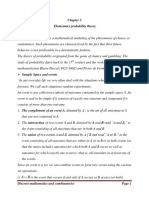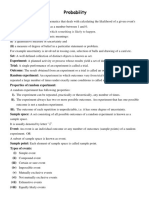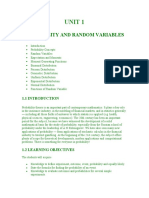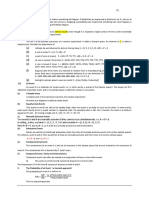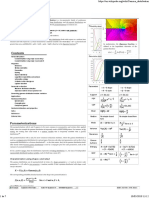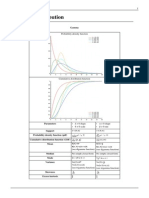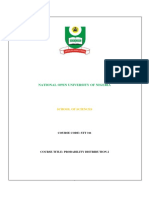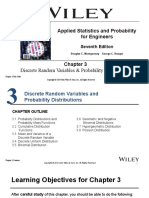0% found this document useful (0 votes)
82 views10 pagesProbability
This document defines key concepts in probability:
1) A random experiment is an experiment with known outcomes that can be repeated under identical conditions, with the actual outcome unknown in advance. Examples include coin tosses or dice rolls.
2) Elementary events are the possible outcomes of a random experiment. The sample space is the set of all possible elementary events.
3) An event is a subset of the sample space, consisting of one or more elementary events. Events include outcomes like "rolling an even number."
4) Probability is defined as the number of favorable outcomes divided by the total number of outcomes, when the outcomes are equally likely. Probability ranges from 0 to 1.
Uploaded by
Narendra GaddamCopyright
© © All Rights Reserved
We take content rights seriously. If you suspect this is your content, claim it here.
Available Formats
Download as DOC, PDF, TXT or read online on Scribd
0% found this document useful (0 votes)
82 views10 pagesProbability
This document defines key concepts in probability:
1) A random experiment is an experiment with known outcomes that can be repeated under identical conditions, with the actual outcome unknown in advance. Examples include coin tosses or dice rolls.
2) Elementary events are the possible outcomes of a random experiment. The sample space is the set of all possible elementary events.
3) An event is a subset of the sample space, consisting of one or more elementary events. Events include outcomes like "rolling an even number."
4) Probability is defined as the number of favorable outcomes divided by the total number of outcomes, when the outcomes are equally likely. Probability ranges from 0 to 1.
Uploaded by
Narendra GaddamCopyright
© © All Rights Reserved
We take content rights seriously. If you suspect this is your content, claim it here.
Available Formats
Download as DOC, PDF, TXT or read online on Scribd
/ 10










